BANNED! New rules for Florida as it fights back against the worst marine invasion in state history
By Ret Talbot
This online article is an excerpt which first appeared in CORAL Magazine’s July/August 2014 issue, pages 48-54. Be sure to see the full issue for several additional stories on this topic.
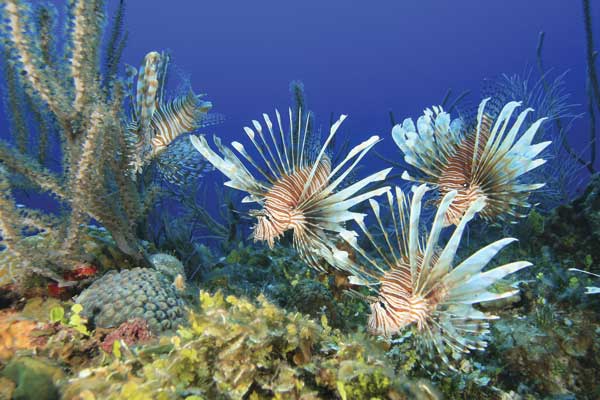
Invasive Pterois volitans combing a lagoon as a team in the Bahamas, where they are a serious threat to populations of native species, whose juveniles are easy prey. Volitans Lions represent some 93% of the Atlantic population of invasives, with Devil Lionfish, P. miles, make up the remaining 7%. Image Rich Carey/Shutterstock
After many months of fact-finding and testimony, the seven Florida Fish and Wildlife Conservation Commission (FWC) commissioners in mid-June voted unanimously to approve controversial final state rules that make importing lionfish from the genus Pterois illegal effective August 1st. This is serious business, as Florida spends in excess of half a billion dollars annually combatting invasive species. In addition the commissioners approved widely-supported lionfish rules that allow persons diving by means of a rebreather to harvest and possess lionfish and also allow the Executive Director to issue permits to events in order to allow the use of spearfishing gear to remove lionfish or other nonnative invasive species in areas where spearfishing is otherwise prohibited.
The actions were taken against the backdrop of the most destructive marine fish invasion ever documented in the western Atlantic and perpetrated by two lionfish from the genus Pterois: P. volitans and P. miles.
Most stakeholders agree banning the two established and invasive species of lionfish is a good idea. Unlike the other species in the genus, the best available science suggests that an import ban on these two species may in fact assist with mitigating the lionfish invasion. Recent studies have shown that a more robust lionfish fishery targeting the animals for both food and aquarium use can help deplete invasive populations. Because the food fishery and the aquarium fishery often target different sized lionfishes, encouraging both fisheries is critical. Banning P. volitans and P. miles from import will, FWC contends, create more demand for the harvest of invasive lionfishes and will in turn benefit native wildlife and ecosystems.
LUMPING LIONFISH
Jeff Turner, president of the Florida Marine Life Association (FMLA), which represents many of the state’s professional fish collectors, was one of several individuals who provided stakeholder comment as the FWC lionfish rules were being drafted. FMLA represents many of the State’s professional fish collectors. Like everyone who provided public comment on the lionfish rules at the draft rule hearing in April, Turner suggested the State should only ban the two currently established and invasive species of the genus from import.
“Lumping all of the lionfish species together was much easier for the State to enforce than trying to figure out which ones are which upon importation. I personally objected to this species-specific scenario, also knowing that it was—and is—is highly unlikely that these other species pose an issue.” (Turner is on the board of advisors of CORAL Magazine.)
By deciding to include all species in the genus in the import ban, FWC has banned the importation of several popular aquarium lionfishes that have never been reported in Florida waters. Both the Mombasa Lionfish (P. mombasae) and the Radiata Lionfish (P. radiata) are small, attractive lionfishes from the banned genus that will no longer be available to Florida aquarists. This will, according to some aquarium industry leaders in the state, put Florida-based importers and wholesalers at a competitive disadvantage.
For one, Sandy Moore, vice president of Florida-based Segrest Farms and an aquarium trade leader, believes the new rules will hurt her business. Segrest Farms is the largest import- wholesale aquarium fish business in the state of Florida and one of the largest in North America. “For our customers looking for other types of Pterois [besides P. volitans and P. miles], we will lose not just the sales of those particular fish, but the entire order. It will have a significant impact on us.”
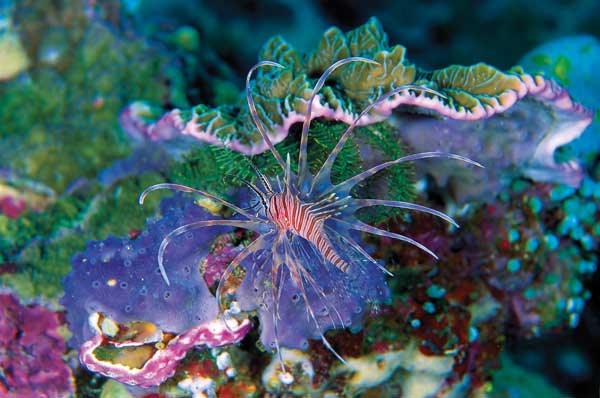
Juvenile Clearfin Lionfish (Pterois russelli, formerly called P. kodipungi), a species from the Coral Triangle. It is one of the fish now banned from imports into Florida. Image by Gary Bell @ OCEANWIDE IMAGES
STOPPING THE NEXT INVASION
The new rules allow harvest of invasive P. volitans and P. miles in Florida state waters for the aquarium fishery, food fishery and recreational fishery, and Florida wholesalers will be able to buy and sell these two species so long as they are collected in Florida waters.
The argument for banning a species because it is similar to another species that has caused harm makes sense on one level. After all, one of the most important goals of state wildlife managers is to prohibit the next invasive species, especially in Florida, a state under siege from non-native reptiles, fishes and plants. According to an FWC spokesperson, “The species that belong within this genus [Pterois] all have similar biology and characteristics to the two species that have been successful in invading Florida waters. This indicates that others within that genus might be successful.”
Dr. Pam Schofield, a U.S. Geological Survey (USGS) nonindigenous species expert and co-author of the Field Guide to the Nonindigenous Marine Fishes of Florida says no other lionfish besides P. volitans and P. miles has ever been reported in Florida waters. She says she doesn’t know why that is the case, but she’d like to keep it that way. “Maybe because [P. volitans and P. miles] are the most common in the trade?” she offers and then adds, “I wish I knew, because that would help us predict the next invader.”
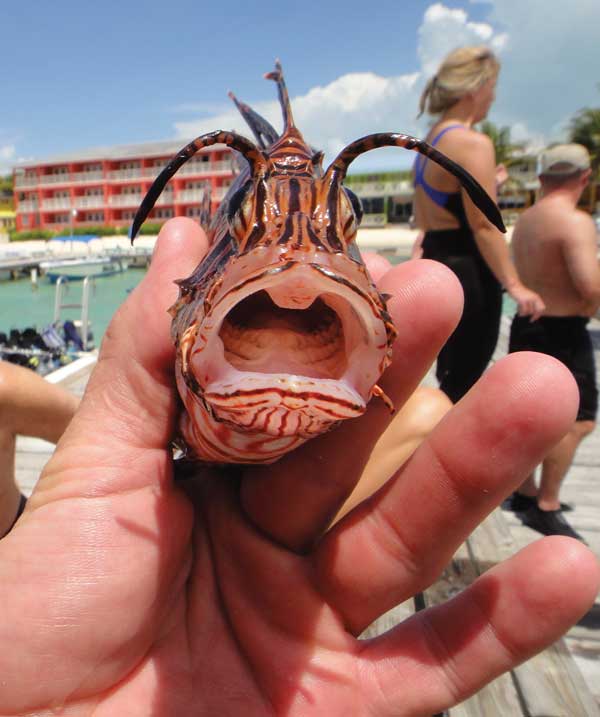
Small lionfish killed by a divemaster in Belize in the far western Caribbean Sea. Image by Serce Melki / WIKI COMMONS
NEEDED RULES OR SIMPLY PUNITIVE?
Both Turner and Moore believe there are already rules and laws in place in the State that regulate the aquarium trade and, according to Moore, make this import ban on the entire genus little more than punitive.
“The trade in marine ornamental, and freshwater species, is already regulated by the States and Federal Governments,” says Turner. “There are laws in place and consequences for the violators who break the laws. I do think this is just the beginning at a more thorough look at our industry as a whole, and the industry needs to take note and act first as it relates to educating the public about how important it is to not release non-native species into the wild waters period.”
Moore believes import facilities like Segrest should be allowed to import and handle the species of lionfishes now banned from import and unavailable in Florida waters as so-called “conditional species.” Segrest Farms currently handles other conditional species such as freshwater stingrays from the genus Potamotrygon without incident. From a business perspective, she says having the ability to acquire a permit from FWC for conditional holding of lionfish species is “the only option, and I hope FWC is open to that option.”
There are species of freshwater fishes that are banned from import all together like piranhas, but Moore says it’s not a good comparison to lionfish. While she says Segrest has lost some sales because of piranhas and some other freshwater fish species being on the Florida prohibited species list, she believes the lionfish situation is quite different. “I’ve lost some sales from not having piranha,” she says, “but trade in them is very limited. It’s very understandable to us and to our customer base why they are not allowed in Florida.” Moore says she feels the same way about most of the species on the freshwater prohibited species.
BUT NOT ABOUT LIONFISH
“The lionfish is not the same,” Moore contends. “[Banning all lionfish from the genus Pterois] sets a precedent that predatory marine fish are not welcome here because the industry-hobby is not responsible.”
This gets at one of the aspects of the rule that bothers Moore most—the notion that the hobby is irresponsible. She feels the ban is unfairly punitive for the marine aquarium trade and marine aquarium hobbyists. Moore does not accept the premise that the aquarium trade is responsible for the lionfish invasion in the state of Florida, as she simply does not believe aquarists could have released enough lionfish to cause the invasion. She, for one, suspects the invasion might be traced to juvenile or larval lionfish released with bilge water from ships coming into the port of Miami.
Most scientists who have studied the lionfish invasion in the western Atlantic disagree, and those that have focused on the genetic fingerprints of the invasion, say that a relatively few individuals released as a result of the aquarium trade and hobby are likely responsible for the invasion (see page 60).
FAILED ARGUMENTS AND BIOSECURITY
While most stakeholders, including many representing the aquarium trade, agree an import ban on the two established and invasive species of lionfish is an appropriate course of action for the state of Florida, many also argue that the rule is too broad in its scope. “We appreciate the FWC’s efforts to manage the impacts of lionfish off the coast of Florida,” said Marshall Meyers, CEO and senior advisor, of the Pet Industry Joint Advisory Council (PIJAC) before the final approval. “The draft rules proposed by FWC take a step in the right direction, removing regulatory barriers to harvest and encouraging removal through a variety of outreach efforts.”
Where Meyers thinks the new rules misstep is in the fact that it bans from import species of lionfish that are neither invasive nor even reported to date in state waters. “We suggest that consideration should be given to classifying Pterois species—other than P. volitans and P. miles—under the FWC’s conditional species rules.” Despite this request made to the state during the period of stakeholder input, FWC has approved a complete ban, and according to an FWC spokesperson, they are not considering listing any lionfishes under the conditional species rules.
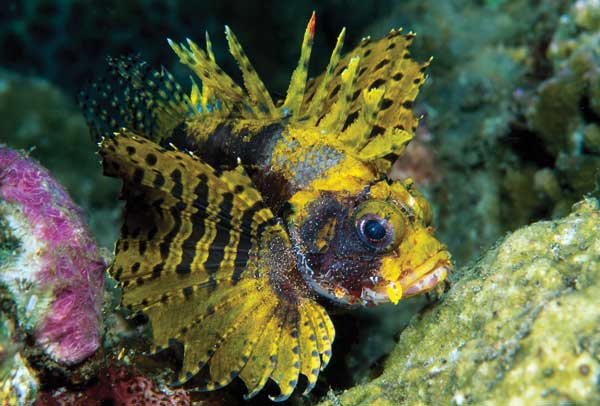
Fuzzy Dwarf Lionfish (Dendrochirus brachypterus) is a species not affected by the Florida ban. This species remains small and is more challenging to keep for aquarists. Image by Gary Bell @ OCEANWIDE IMAGES
If the eight other Pterois lionfish species were added to the condition species list instead of the prohibited species list as Meyers suggests, it would allow for the issuance of permits for the importation of these lionfish species for sale outside the state of Florida. The imported lionfish would need to be held in closed systems with no access to the State waterways as stipulated in Florida Administrative Code, but, he points out, this is already done with several other species of non-native wildlife. “We submit that these bio-security measures have been implemented successfully for the transshipment of other species of concern in Florida with no adverse incidents.”
For Marshall Meyers of PIJAC, it comes down to doing the due diligence when it comes to assessing risk. “We advocate conducting risk analyses for non-native species with elevated risk of adverse impacts prior to the promulgation of regulatory restrictions,” says Meyers. “These transparent processes allow for stakeholder involvement in the development of risk mitigation strategies, including regulatory and non-regulatory options.” Meyers points out that PIJAC has long been involved in risk analysis, dating back to the first national model—the Generic Nonindigenous Aquatic Organisms Risk Review Process, developed under the aegis of the Aquatic Nuisance Species Task Force)—and we would be happy to provide our expertise to reduce the risks to the State of Florida.
MIXED REVIEWS— FROM ANGER TO CAUTIOUS OPTIMISM
“The Florida ban could quickly turn into a nationwide ban,” cautions Sandy Moore, “the same as the python ban.”
Many aquarium industry leaders like Moore worry that the aquarium trade is at risk of being regulated and legislated out of existence. “Our detractors would not have us trade in ‘exotic species’ for fear of invasiveness. Remember HR669?” she asks referring to The Nonnative Wildlife Invasion Prevention Act that was proposed at the Federal level. “That would have stopped trade of all fish except common goldfish.
“It is our duty not to release pets into the wild. They are ill-equipped to survive and it is not only wrong, but cruel and illegal.” Insofar as the non-native aquarium animals are concerned, Moore says, “We will lobby for conditional permits, and object this arbitrary ban wherever it is proposed. We shouldn’t so quickly give up our right to choose the pet that best suits us, as long as we give our pets a life worth living.”
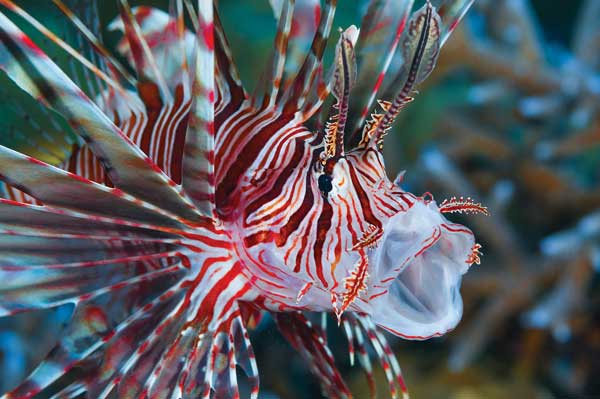
Yawning Volitans Lionfish currently living without fear of predators in its new Western Atlantic range. Whether New World sharks, groupers, eels and other Atlantic species will learn to prey on them is a large unknown. Image by Gary Bell @ OCEANWIDE IMAGES
While many of those in the aquarium trade express anger over the “broad brush” FWC employed when it banned the whole genus, the ban has widespread support amongst the public in Florida. Florida is literally under assault from invasive species, and the lionfish invasion has become a very public story. While nobody thinks the new lionfish rules will eradicate invasive lionfishes from Florida waters, most of the new rules will assist in controlling the invasive populations.
“It is good to see the FL FWC taking action on the lionfish issue,” says Lad Akins, Director of Operations of Reef Environmental Education Foundation (REEF). “Removing rebreather restrictions and easing permitting requirements are good steps in the right direction,” says Akins. REEF has played a leading role in dealing with the lionfish invasion of the western Atlantic, and few individuals are as involved as Akins. “The prohibition on the import of live lionfish has many pros and cons and it will remain to be seen how this plays out.” Akins presented public comment on several occasions suggesting only the two established and invasive species should be banned. He also, along with others, advocated for allowing imports from other states and countries in the invasive range. “Overall, we are in favor of the FWC’s new rule changes and look forward to continuing to work on tools and technologies to address lionfish impacts.”
“Aquariums are beautiful and fascinating educational tools that warrant significant consideration from the authorities on how far they want to go to enforce the laws already on the books,” says Turner, who points out that many non-native species are already institutionalized into the State’s psyche. “Our great State of Florida has tremendous investments in the culture of hundreds of species of freshwater ornamentals, and [there are] a ton of them loose in the lakes, canals and rivers in our state. Peacock Bass, Cichla spp., are a highly sought after gamefish in South Florida, and guides will regularly bring people to target this fish. Lionfish is a whole other story, and is the first marine invasive species to take hold in our waters. It’s not a good thing at all, and the State might get more involved with a better educational campaign aimed at aquarist and aquarium stores and wholesalers as the best solution to handle the situation moving forward.”
While education is a powerful tool and the State is doing more to raise awareness about the danger of non-native species, it seems that, at least for the time being, state wildlife managers are also willing to use more extreme measures in the fight against invasive nonnative species.
Like what you read? Be sure to support CORAL Magazine’s in-depth, professional aquarium journalism, bringing you meaningful content that makes a difference!
(Buy This Back Issue | Subscribe Now)
Image Credits:
Volitans Lionfish in Caribbean Lagoon – Rich Carey/Shutterstock
Juvenile Clearfin Lionfish, Dwarf Lionfish, and Yawning Volitans Lionfish – Gary Bell @ OCEANWIDE IMAGES
Small harvested Lionfish – Serce Melki / WIKI COMMONS
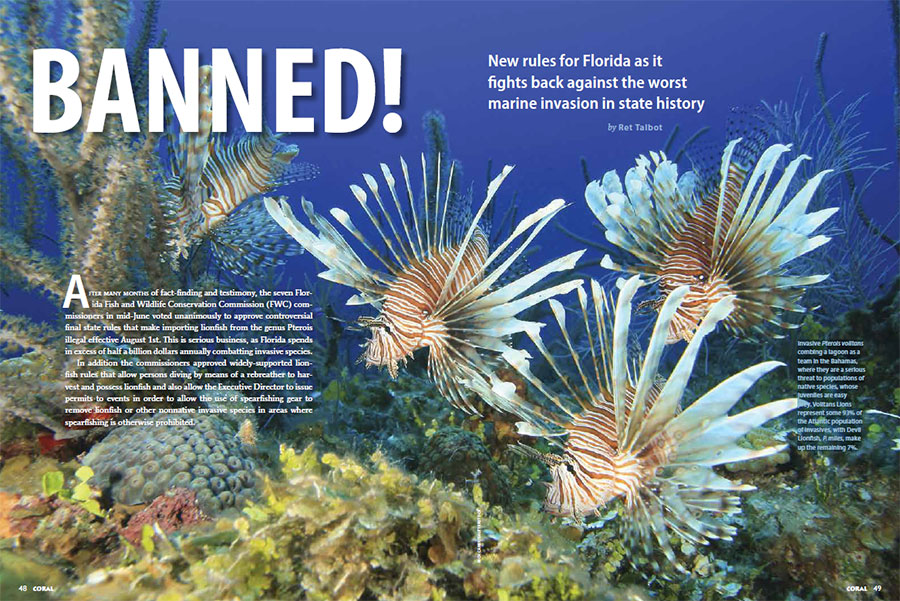





iapresheting this work